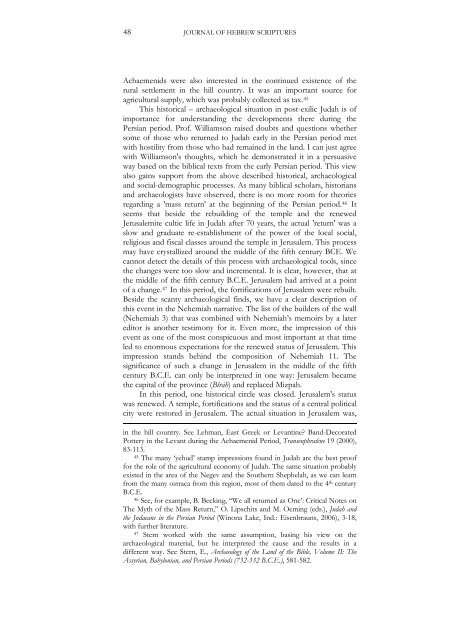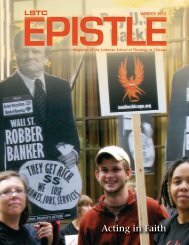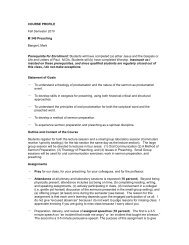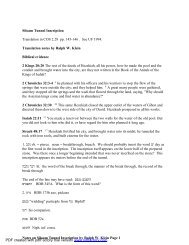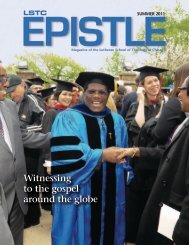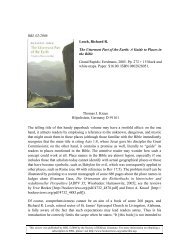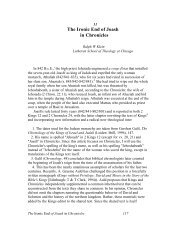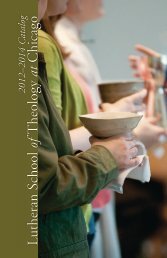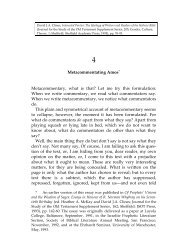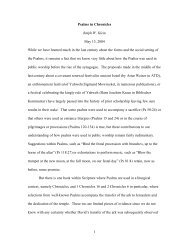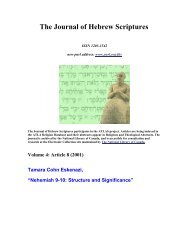Download this PDF file - University of Alberta - Journal Hosting
Download this PDF file - University of Alberta - Journal Hosting
Download this PDF file - University of Alberta - Journal Hosting
Create successful ePaper yourself
Turn your PDF publications into a flip-book with our unique Google optimized e-Paper software.
48JOURNAL OF HEBREW SCRIPTURESAchaemenids were also interested in the continued existence <strong>of</strong> therural settlement in the hill country. It was an important source foragricultural supply, which was probably collected as tax. 45This historical – archaeological situation in post-exilic Judah is <strong>of</strong>importance for understanding the developments there during thePersian period. Pr<strong>of</strong>. Williamson raised doubts and questions whethersome <strong>of</strong> those who returned to Judah early in the Persian period metwith hostility from those who had remained in the land. I can just agreewith Williamson's thoughts, which he demonstrated it in a persuasiveway based on the biblical texts from the early Persian period. This viewalso gains support from the above described historical, archaeologicaland social-demographic processes. As many biblical scholars, historiansand archaeologists have observed, there is no more room for theoriesregarding a 'mass return' at the beginning <strong>of</strong> the Persian period. 46 Itseems that beside the rebuilding <strong>of</strong> the temple and the renewedJerusalemite cultic life in Judah after 70 years, the actual 'return' was aslow and graduate re-establishment <strong>of</strong> the power <strong>of</strong> the local social,religious and fiscal classes around the temple in Jerusalem. This processmay have crystallized around the middle <strong>of</strong> the fifth century BCE. Wecannot detect the details <strong>of</strong> <strong>this</strong> process with archaeological tools, sincethe changes were too slow and incremental. It is clear, however, that atthe middle <strong>of</strong> the fifth century B.C.E. Jerusalem had arrived at a point<strong>of</strong> a change. 47 In <strong>this</strong> period, the fortifications <strong>of</strong> Jerusalem were rebuilt.Beside the scanty archaeological finds, we have a clear description <strong>of</strong><strong>this</strong> event in the Nehemiah narrative. The list <strong>of</strong> the builders <strong>of</strong> the wall(Nehemiah 3) that was combined with Nehemiah’s memoirs by a latereditor is another testimony for it. Even more, the impression <strong>of</strong> <strong>this</strong>event as one <strong>of</strong> the most conspicuous and most important at that timeled to enormous expectations for the renewed status <strong>of</strong> Jerusalem. Thisimpression stands behind the composition <strong>of</strong> Nehemiah 11. Thesignificance <strong>of</strong> such a change in Jerusalem in the middle <strong>of</strong> the fifthcentury B.C.E. can only be interpreted in one way: Jerusalem becamethe capital <strong>of</strong> the province (Bîrāh) and replaced Mizpah.In <strong>this</strong> period, one historical circle was closed. Jerusalem's statuswas renewed. A temple, fortifications and the status <strong>of</strong> a central politicalcity were restored in Jerusalem. The actual situation in Jerusalem was,in the hill country. See Lehman, East Greek or Levantine? Band-DecoratedPottery in the Levant during the Achaemenid Period, Transeuphratène 19 (2000),83-113.45 The many ‘yehud’ stamp impressions found in Judah are the best pro<strong>of</strong>for the role <strong>of</strong> the agricultural economy <strong>of</strong> Judah. The same situation probablyexisted in the area <strong>of</strong> the Negev and the Southern Shephelah, as we can learnfrom the many ostraca from <strong>this</strong> region, most <strong>of</strong> them dated to the 4 th centuryB.C.E.46 See, for example, B. Becking, ‘‘We all returned as One’: Critical Notes onThe Myth <strong>of</strong> the Mass Return,” O. Lipschits and M. Oeming (eds.), Judah andthe Judaeans in the Persian Period (Winona Lake, Ind.: Eisenbrauns, 2006), 3-18,with further literature.47 Stern worked with the same assumption, basing his view on thearchaeological material, but he interpreted the cause and the results in adifferent way. See Stern, E., Archaeology <strong>of</strong> the Land <strong>of</strong> the Bible, Volume II: TheAssyrian, Babylonian, and Persian Periods (732-332 B.C.E.), 581-582.


